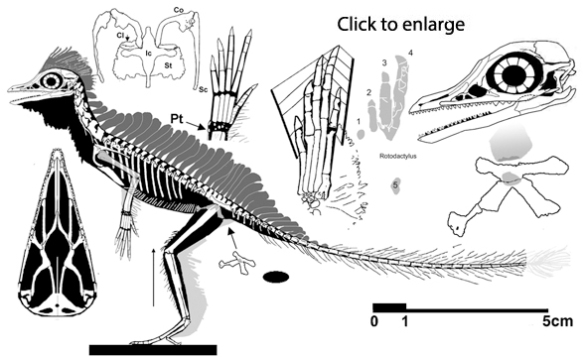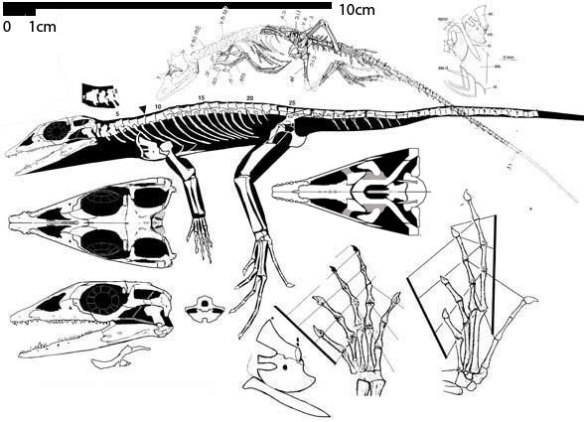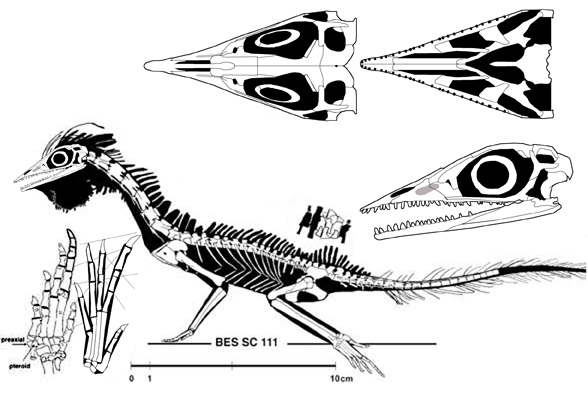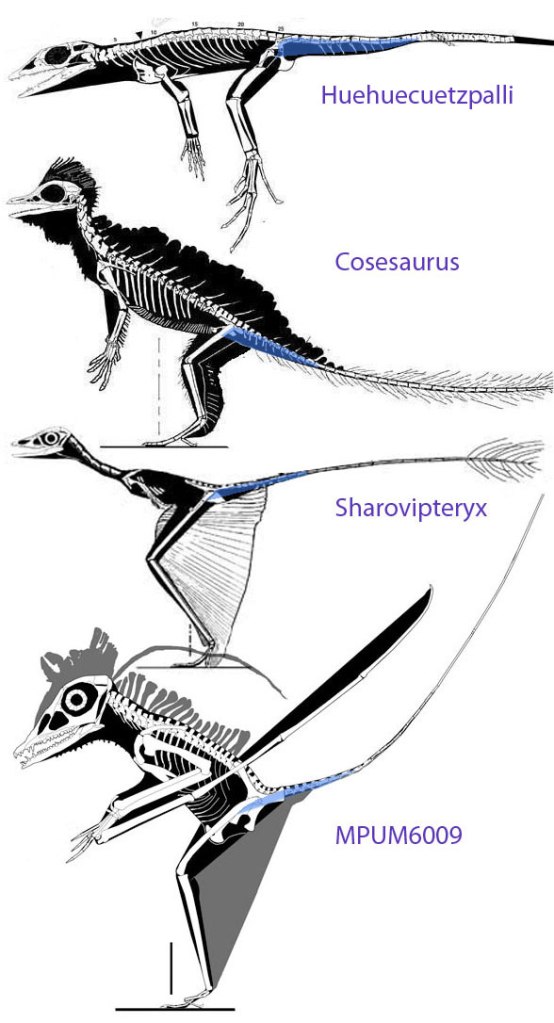Not sure I agree with this,
even though this hypothesis fits nicely into the hypothesis by Peters (2000a, 2000b, 2007) that many (but not all) Huehuecuetzpalli (Fig. 1) phylogenetic descendants also had a facultative to obligatory bipedal gait. These taxa include Langobardisaurus to Tanystropheus, to Macrocnemus (Fig. 2) to Cosesaurus (Fig. 3), Sharovipteryx, Longisquama and pterosaurs (Fig. 4).
Early to Middle Triassic tracks
matching the pes of Cosesaurus, named Rotodactylus (fig. 3, Peters 2000b), show the transition to bipedal locomotion happening 100 million years earlier in lepidosaurs. Early Cretaceous Huehuecuetzpalli might have been a wee bit too soon (phylogenetically) and too late (chronologically) for the first instance of a bipedal lepidosaur.
Usually bipedal lizards
have a longer neck (for reasons that escape me) and an extra sacral or three to anchor a slightly to greatly elongate ilium, as found in a little Macrocnemus, the BES SC 111 specimen (Fig. 2) and littler Cosesaurus (Fig. 3).
From the highlights and abstract
• The extinct lizard Huehuecuetzpalli mixtecus had a bipedal gait.
• The ancestral condition in lizards is inferred to be terrestrial.
• The ancestral condition in lizards is inferred with hindlimbs longer than forelimbs.
• The bipedal gait was common in lizards since the lower Cretaceous.
Abstract:
“Representative locomotion types in lizards include terrestrial, arboreal, grass swimmer, sand swimmer and bipedal. Few studies explain the locomotion habit of extinct lizards, and even less asses [= fewer assess] those of bipedal ones. Here, we use quantitative methods to infer the type of locomotion of two Albian Mexican lizards (Lower Cretaceous) and three Cretaceous lizards from Brazil, North America and Spain, assessing the similarities of the hindlimb-forelimb length ratio amongst extinct and extant species. Additionally, an ancestral character state reconstruction analysis was performed, to evaluate the evolution of lizard locomotion habits. The species Huehuecuetzpalli mixtecus was bipedal while Tijubina pontei was facultative bipedal, Hoyalacerta sanzi, Tepexisaurus tepexii and Polyglyphanodon sternbergi cannot be differentiated amongst terrestrial or arboreal with the approach used in this work. The ancestral character state reconstruction analysis showed a terrestrial ancestral locomotion type, with a basal character state of hindlimbs longer than forelimbs. Equal length between hind and forelimbs appear to be a derivate state that evolved multiple times in lizard evolutionary history.“

Taxon exclusion mars this study.
The authors think Huehuecuetzpalli is an early member of Squamata and Iguania. It is not. This genus has been historically hard to classify due to taxon exclusiion.
The authors describe their methods.
“Photographs were taken of the forelimbs (humerus, radius, ulna) and hindlimbs (femur, tibia, fibula) of 36 existing species of lizards, all with their respective measurement scale.” “The hindlimb-forelimb length ratio was calculated as the sum of the femur and tibia longitudes (hindlimb length) divided by the sum of the humerus and ulna longitudes (forelimb length), in mm.” Huehuecuetzpalli scored a 1.58. Bipedal lizards scored 1.42 to 1.9 with a 1.85 median. “This led us to infer that Huehuecuetzpalli mixtecus was a bipedal lizard supported by all analyses, like extant lizards Basilicus, Laemanctus, and Corytophanes.”
Longer hind limbs do not necessarily make a lepidosaur a biped.
Cosesarus has similar hind limbs to Huehuecuetzpalli (Fig. 4), and we have cosesaur tracks (ichnite: Rotodactylus) that show it as a quaruped and narrow-gauge biped. Then again, Sharovipteryx, Longisquama and Bergamodactylus (Fig. 4) were obligate bipeds. Their stem-like, locked-down coracoids indicate they were flapping, not walking, with their forelimbs.
References
Peters D 2000a. A Redescription of Four Prolacertiform Genera and Implications for Pterosaur Phylogenesis. Riv. It. Paleo. Strat. 106(3): 293-336.
Peters D 2000b. Description and Interpretation of Interphalangeal Lines in Tetrapods. Ichnos 7: 11-41.
Peters D 2007. The origin and radiation of the Pterosauria. Flugsaurier. The Wellnhofer Pterosaur Meeting, Munich 27.
Peters D 2011. A catalog of pterosaur pedes for trackmaker identification. Ichnos 18(2): 114-141.
Peters D 2017 unpublished accessible here. Cosesaurus aviceps, Sharovipteryx mirabilis and Longisquama insignis Reinterpreted.
Reynoso V-H 1998. Huehuecuetzpalli mixtecus gen. et sp. nov: a basal squamate (Reptilia) from the Early Cretaceous of Tepexi de Rodríguez, Central México. Philosophical Transactions of the Royal Society, London B 353:477-500.
Villaseñor-Amador D, Suárez NX and Crus JA 2021. Bipedalism in Mexican Albian lizard (Squamata) abd the locomotion type in other Cretaceous lizards. Journal of South American Earth Sciences 109:103299.



